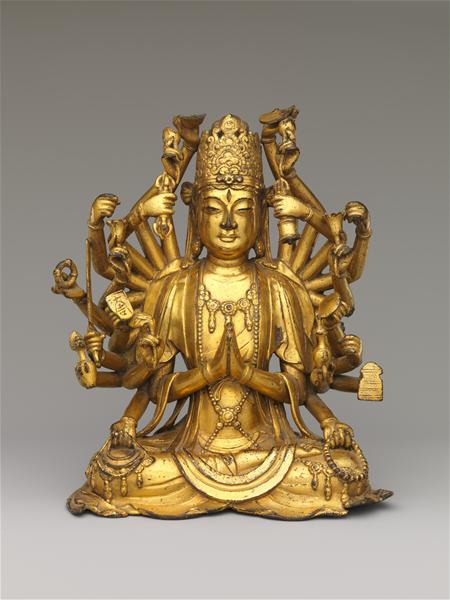6. De vigtigste læringstraditioner 2. Mahayana
Uddrag af Lotussutraen
Disse uddrag (kap. 1, kap. 2 og kap. 16) stammer fra Lotussutraen, en af de mest populære og indflydelsesrige mahayanasutraer. De ældste dele af teksten er formentlig skrevet mellem 100 f.v.t. og år 100, og den største del af teksten fandtes ved år 200. Teksten er oprindelig skrevet på sanskrit og eksisterede i år 300 i kinesisk oversættelse; den blev en af de mest udbredte sutraer i Østasien. Den fremstiller vigtige, læringsmæssige nyskabelser, såsom forestillingen om en overjordisk Buddha, som hele tiden tilpasser sin lære for at hjælpe jordiske væsener med at opnå frigørelse.
Excerpt 1
"Thus have I heard, at one time the Buddha dwelt on Mount Grdhrakuta, near the City of the House of the Kings, together with a gathering of Great monks [...]. After the Buddha had spoken this Sutra, he sat in full lotus and entered the meditation of the station of limitless principles, body and mind unmoving.
At that time there fell from the heavens a rain of mandarava flowers, mahamandarava flowers, manjushaka flowers, and mahamanjushaka flowers, which were scattered upon the Buddha and the entire great assembly.
All the Buddhas universes quaked in six ways.
At that time the entire great assembly of monks, lay devotees, gods, dragons, yakshas, gandharvas, asuras, garudas, kinnaras, mahoragas, beings human and non-human, as well as the minor kings, the wheel-turning sage kings, all attained what they had never had before. They rejoiced and joined their palms and, with one heart, gazed upon the Buddha.
Then the Buddha emitted from between his brows a white hair-mark light which illumined eighteen thousand worlds to the east, omitting none of them, reaching below to the Avichi hells and above to the Akanishtha Heaven. From this world were seen all the living beings in the six destinies in those lands".
Excerpt 2
"At that time the World Honored One arose serenely from meditation and told Shariputra, “The wisdom of all the Buddhas is extremely profound and unlimited. The gateway to this wisdom is difficult to understand and difficult to enter. It cannot be known by any of the Hearers or solitary Buddhas.
What is the reason? The Buddhas have, in the past, drawn near to countless hundreds of thousands of tens of thousands of millions of Buddhas, exhaustively practicing the unlimited teachings of the Way of those Buddhas. They are forging ahead with courage and vigor and their names are known everywhere.”
“They have accomplished the most profound Teaching, one which has never been before, and speak of it according to what is appropriate, but its purport is difficult to understand.”
“Shariputra, from the time I realized Buddhahood, I have, by means of various causes and conditions and various analogies, extensively proclaimed the verbal teaching. With countless skillful means, I have guided living beings, leading them to separate from all attachments.”
Excerpt 3
"From the time I attained Buddhahood, The eons that have passed Are limitless hundreds of thousands of myriads [...]
I always speak the Dharma to teach and transform
Countless millions of living beings,
So they enter the Buddha-Way.
And throughout these limitless eons,
In order to save living beings,
I expediently manifest Nirvana.
But in truth I do not pass into quiescence.
I remain here always speaking the Dharma.
At that time I and the assembly
All appear together on Magic Vulture Mountain,
Where I say to living beings
That I am always here and never cease to be".
Excerpts from the Lotus Sutra
Oversat af The Buddhist Text Translation Society
http://cttbusa.org/lotus/lotus_contents.asp
(kap. 1, kap.2 + kap. 16)
Bodhisattva

En repræsentation af Boddhisattva, kaldet Avalokiteshvara. Boddhisattva udgør fuldkommenhedsidealet for folk, der praktiserer mahayanabuddhisme, nemlig ved at opnå erkendelse, men samtidig hjælpe andre hen mod samme mål. Denne forestilling banede vej for dyrkelsen af himmelske boddhisattvaer, som man kan bede til for at få hjælp til at opnå frigørelse.
Boddhisattva Avalokiteshvara med et tusind hænder og et tusind øjne
Kina, 1000-1100-tallet
Bronze
Credit Line: Rogers Fund 1956
Metropolitan Museum of Art (New York)
http://www.metmuseum.org
Amitayus Buddha i sit Paradis

Dette maleri forestiller Amitayus, en af de højst ærede overjordiske buddhaer i mahayanabuddhismens panteon. Denne fremstilling af et vidunderligt Paradis afspejler en udvikling væk fra et abstrakt ideal for frigørelse – såsom udslukningen i Nirvana – til en mere forsonlig himmel.
Amitayus Buddha i sit Paradis
Tibet, ca. 1700
Limfarve med guld på stof
Credit Line: Køb, Barbara og William Karatz
Metropolitan Museum of Art (New York)
http://www.metmuseum.org






